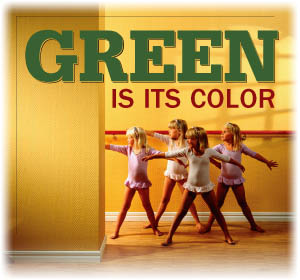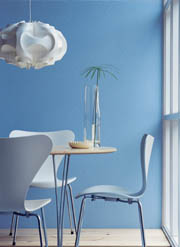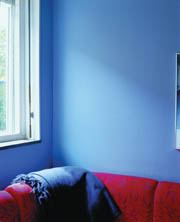
For the last couple of years, each and every design trade show has had its green section. At North America's Neo Con, the largest design show in the world, it is called the Greenlife Sustainable Design Exhibit. What used to be considered a limited trend is about to become a tidal wave.
The primary driver for this trend is the worldwide general and long awaited consensus foremost amongst architect's and interior designers that specifying environmentally friendly products will equate to creating healthy places for work and life.
Most recently, the added element in achieving environmentally friendly design, sought after by leading architects, has been the quest to add performance and sustainability to the list of qualifiers that products must demonstrate in order to qualify for the coveted title of "environmentally green."

LEED by example
Whether specifying products intended for a small home, a school, hospital or skyscraper offices, architects recognize that our interior environments must not only deliver green healthy spaces but that those spaces need to meet performance standards that have traditionally been set by manmade products focused on cleanability, abrasion and impact resistance.Our specifying community of architects and interior designers are also heavily supported by governmental institutions and their regulations directed toward promoting superior building standards which are respectful of our natural resources and our communities. The list of supporting organizations is long, including the Environmental Protection Agency, Sustainable Buildings Industry Council and the Occupational Safety and Health Administration, to name just a few.
Most recent and best known for its ability to quantify the degree of product effectiveness in delivering green to the construction industry is the U.S. Green Building Council. This organization is quickly setting the standards through its Leadership in Energy and Environmental Design program. The LEED system produces four levels of certifications: Certified, Silver, Gold and Platinum. Based on sustainability, efficiency, indoor air quality, innovation and design factors, points are attributed to the registered building projects. To date, more than 150 million square feet of built space is being delivered within LEED registered projects.
These green programs have a big impact on the types of architectural finishes, which the manufacturing industry is choosing to invest in for delivery to its customers. A front row example of this are the standards set by the LEED rating system that is being followed by those manufacturers choosing to establish themselves quickly as the leaders in their particular product fields.
Vinyl forever
Influences of this regard are being observed most obviously over the past three years in the vinyl wall covering industry. This sector has lost-whether rightly or wrongly-nearly 25 percent of its market share as a direct result of environmental concerns. This loss of market share helps to explain why manufacturers have been investing heavily into research and product development to deliver architectural finishes and manufacturing processes that are to varying degrees better for the environment and therefore healthier for people.As manufacturers march forward in their production to meet market demand for greener products, the argument that many traditional products also deliver a necessary solution for a greener environment is being made. As an example, the vinyl industry is responding both with added research and development investments in greener products, while explaining the need to create long term and more sustainable design with some of the traditional vinyl products. They cite examples of vinyl's necessity in life sciences and pollution control, to name just a few uses that cannot be fulfilled by any other technology to date.
And here is the big entrance and opportunity for those truly devoted leaders in the supply of environmentally friendly products. Those who have been delivering green without the requisite driver to compete for market share. Companies such as Johns Manville, whose glass textile products made from readily available sand and starch have graced the walls of Europe for decades, and are just now being introduced to the North American marketplace by leading wall covering distributors, such as Glass Textiles North America and RJF International.
These manufacturers understand how crucial it is to adapt to new trends and be perceived as leaders of the new trends. The leading companies have begun to set the standards higher than their market fellows. Their product mottos are the mantra of driver programs, such as LEED. Products qualifying for consideration by the program need to exhibit extensive degrees of durability, while adding aesthetical value. They also have to contribute significantly to and demonstrate leadership in the following key requirements.

Safety
Safe products ensure a high indoor air quality. Air quality can be affected by air pollutants, such as volatile organic components, as well as mold and mildew.The ability of air and vapor to pass through the building envelope has become critical to building design and indoor air quality. High humidity, condensation and poor ventilation are among factors that increase mold. Designers, contractors and end users are concerned about this issue, and they want to use permeable materials that will not facilitate the mold and mildew growth.
"Breathability" is a very important concept when it relates to building safety. Nowadays, mold and mildew are terrible issues since they impact occupant health. Breathable products help to reduce the likelihood of mildew and fungus growth on or beneath the substrate. Mold and mildew cause a lot of health damages, such as allergic reactions, infections, odor and illness. This issue is extremely consequent since some schools and hotels have even had to close. To be able to eliminate the mold and mildew growth, the use of breathable product is crucial. Architects and designers are looking for alternatives to products that are not totally safe. Another manufacturer, Omnova, has just launched Brease, a breathable wall covering.
Sustainable
The best products have to be manufactured using natural, renewable, and recyclable resources and products so that limited resources are conserved, stable economic growth is achieved and damage to the environment is minimized.Products have to be durable and optimize the lifecycle economic performance. Sustainable buildings reduce their operating costs, as well as increase their asset value with high-quality green products.
Sustainable finishes save time and money for end-user customers, while conserving our natural resources. For instance, carpet cushion manufactured from recycled hard carpet waste products, such as those produced by Crosspoint Fabrics are examples of sustainable products, which conserve natural resources.
Sustainability also gives the flexibility to renovate in the future without expensive and wasteful material removal. Glass textile wall coverings are a leading example in this category since they can be refreshed with another coat of paint rather than the wasteful removal of other wall coverings.
Another leader in the industry, Surface Protection Industries International, produces the water-based and breathable commercial coatings branded Zolatone. This company has been devoted to research and development in this area since the '70s. Specifically, Zolatone's durability and re-coatability combine to reduce on-site waste and disposal requirement dramatically. And they require only very simple wall preparation, thereby conserving numerous other resources.
Natural
The ideal product first has to be made of natural and non-toxic components. Natural products are biodegradable. In other words, these products need to be capable of being broken down naturally into environmentally harmless components when relegated to a landfill site.
Grass cloth is the perfect example of a natural product used by interior designers. Other acceptable products can be made of post consumer recycled components. For instance, lightweight gypsum-based ceiling tiles made of post-consumer recycled glass are examples of environmentally natural products.
Totally green
To date, there are few products that can claim to satisfy all these criteria at the same time: performance, natural, sustainability and safety. Some products are green but don't have the performance (i.e., durability, scrubbability). When a product combines all these features, it can be known as a "totally green" product. The totally green concept has been introduced by Glass Textiles North America Inc., a manufacturer and distributor of architectural wall and ceiling finishes.Totally green products are starting the green race with a strong advantage since they address the growing expectations by the architect and designer community's green initiatives. These manufacturers are now putting their focus on delivering "green" and it will be incumbent upon our industry and society to ask them to declare the degree of green in their products. After all, we need to keep them working to continue improving their products for all of us.

Report Abusive Comment